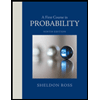
A First Course in Probability (10th Edition)
10th Edition
ISBN: 9780134753119
Author: Sheldon Ross
Publisher: PEARSON
expand_more
expand_more
format_list_bulleted
Question

Transcribed Image Text:Problem 5
Suppose that we have designed a randomized algorithm for
a problem having "Yes" or "No" answer. The algorithm is such that if the answer
is "Yes," it is always correct. If the answer is "No," it is correct with
probability at least 0.02. How many times do we need to run this algorithm in
order to be sure that the probability of getting an erroneous answer is at most
0.02?
Expert Solution
This question has been solved!
Explore an expertly crafted, step-by-step solution for a thorough understanding of key concepts.
This is a popular solution
Trending nowThis is a popular solution!
Step by stepSolved in 2 steps

Knowledge Booster
Similar questions
- eBook Problem 2-11 (Algorithmic) Let A be an event that a person's primary method of transportation to and from work is an automobile and 8 be an event that a person's primary method of transportation to and from work is a bus. Suppose that in a large city P(A) - 0.49 and P(8) -0.37. a. Are events A and B mutually exclusive? What is the probability that a person uses an automobile or a bus in going to and from work? If required, round your answer to two decimal places. b. Find the probability that a person's primary method of transportation is some means other than a bus. If required, round your answer to two decimal places. P(B) =arrow_forwardProblem 3 We propose another model of early propagation of an epidemic, by counting the number of indi- viduals spreading the disease as follows: At day 0, there is one person infected. From a day to the next, every infected individual independently: 1) remains a spreader with probability (w.p.) p, and has either infected exactly one new individual (who becomes a spreader) with conditional probability q, or has not spread the disease with con- ditional probability 1-q. 2) gets definitively removed from the pool of spreaders without infecting anyone else (w.p. 1-p). a. Justify why this model can be described as a branching process (what is the number of spreaders at time n + 1 given the number of spreaders at time n, what is the reproduction law). Find the generating function of the reproduction law. b. We define the contact number o as the average number of individuals directly contaminated by an infected individual before this individual is removed from the pool of spreaders. Show…arrow_forwardHow would I approach this problem?arrow_forward
- Problem 5: A professor tries to count the number of students attending lecture in person. For each student in the audience, the professor either counts the student accurately with probability p or misses the student in the count with probability (1 – p). The exact number of attending students is 20. (a) The number of students counted by the professor is a random variable N. What is the PMF of N? (b) Let U = 20 – N denote the number of uncounted students. What is the PMF of U? (c) What is the probability that the undercount U is 2 or more? (d) For what value of p is E[U] = 2?arrow_forwardDiscrete Mathematics Problem 2 Susie has a bag of marbles containing 3 Red, 7 Green, and 10 Blue marbles. In this problem, the phrase with replacement means that marbles are drawn one at a time and after the draw it is replaced back into the bag before picking the next marble. The phrase without replacement meansthat each marble is drawn and held onto until all marbles are drawn.1. What is the probability of picking 5 marbles and getting at least one red marble? Calculate the probability (a) with replacement, and (b) without replacement. 2. Pick 8 marbles: 4 green and 4 blue. Calculate the probability (a) with replacement and (b) without replacement. 3. If Susie sells you 7 marbles chosen randomly without replacement, what are your chances of getting at least six marbles of the same color?arrow_forwardProblem 14: Suppose that the checkout time at a grocery store is an exponential random variable with mean 4 minutes. Estimate the probability that a cheker will serve more than 77 customers during a 6 hour shift.arrow_forward
- A rat is put into the following maze: moves. 3 flat 1 The rat has a probability of 1/4 of starting in any compartment and suppose that the rat chooses a passageway at random when it makes a move from one compartment to another at each time. Let Xn be the compartment occupied by the rat after n 2 (d) Find the probability that the rat is in compartment 3 after two moves. (e) In the long run, how many times that the rat enters in compartment 4 in 100 movements?arrow_forwardQuestion Carrow_forward
arrow_back_ios
arrow_forward_ios
Recommended textbooks for you
 A First Course in Probability (10th Edition)ProbabilityISBN:9780134753119Author:Sheldon RossPublisher:PEARSON
A First Course in Probability (10th Edition)ProbabilityISBN:9780134753119Author:Sheldon RossPublisher:PEARSON

A First Course in Probability (10th Edition)
Probability
ISBN:9780134753119
Author:Sheldon Ross
Publisher:PEARSON
